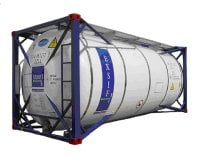20 ft. Tank Containers
20' TANK

内側の長さ:
内側の幅:
内側の高さ:
ドアの幅:
ドアの高さ:
容量:
風袋重量:
最大貨物重量:
6.058 m
2.438 m
2.438 m
0.000 m
0.000 m
0 m3
4190 Kgs
26290 Kgs
説明
Tank containers must be at least 80%% full, to prevent dangerous surging of the liquids in transit. On the other hand, they must not as a rule be over 95%% full, or there will not be sufficient ullage space for thermal expansion. The extent of thermal expansion may be calculated for each cargo on the basis of the following formula:
- ΔV = Va · γ · ΔT
- Ve = Va (1 γ · ΔT)
- ΔV : change in volume
- Va : volume at initial temperature a
- Ve : final volume at temperature e
- γ : coefficient of cubic (thermal) expansion
- ΔT : temperature difference in degrees kelvin
Tank containers intended for transporting foodstuffs must be labeled "Potable Liquids only".
Some hazardous materials must be transported in tank containers with no in- or outlet openings below the surface of the liquid.
Tank containers are generally designed for an operating pressure of up to 3 bar (above atmospheric). The test pressure used is 4.5 bar (above atmospheric).
If the cargo requires temperature-controlled transport, tank containers can be equipped with insulation or heating. The temperature of the cargo may be precisely controlled using temperature sensors.
図
使い方
Tank containers are used for liquid cargoes, such as:
- Foodstuffs: fruit juices, spirits, sweet oils
- Chemicals: hazardous materials, such as fuels, toxic substances, corrosion protection agents


